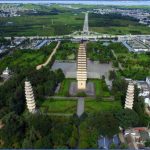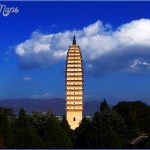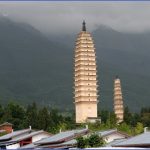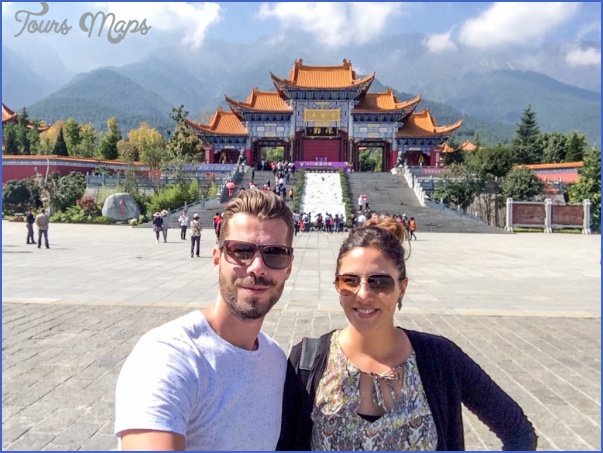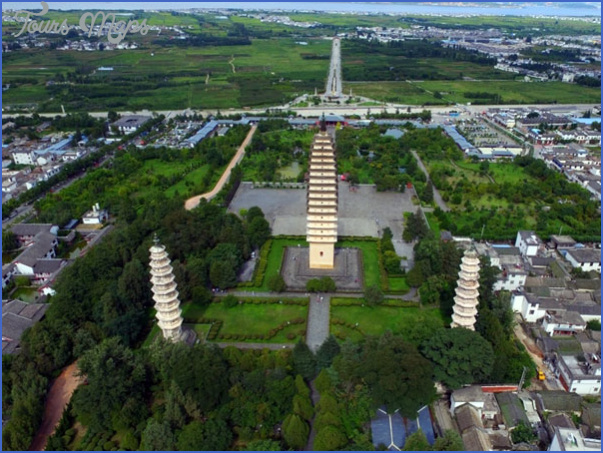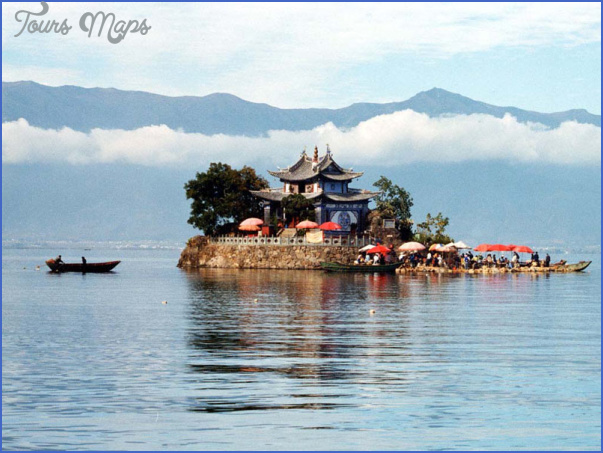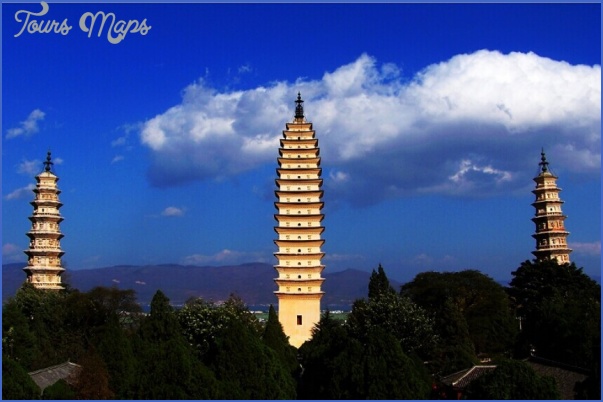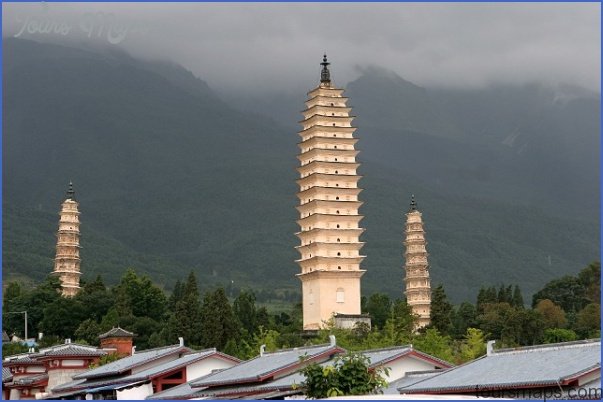Dalian lies at 121°40’E and 38°52’N, at the southernmost tip ofthe Liaodong peninsula. It is linked with Shenyang by rail and a motorway, with Shanghai by regular service ships, and with Beijing and Hong Kong by regular flights taking one and three and a half hours respectively.
Dalian, previously known as Luda (a contraction formed from Lushun and Dalian), boasts one of the largest trading ports in China. It forms one of China’a special commercial zones, with shipyards, engineering and rolling-stock works, as well as steel, chemicals, petro-chemicals, cement, textiles and canned foods.
Dalian is famed for its apples, which the Chinese prefer to any other fruit, and because of its mild climate and many sandy beaches it has become one ofthe most popular summer holiday resorts in northern China.
It is uncertain when the town was founded. All that is known is that after 108 b.c., when Emperor Han Wudi opened a shipping line between the Liaodong and Shandong peninsulas, it expanded considerably. In the late 19th c. the Manchurian government set up a naval base in Dalian which gave it a further economic boost. From 1894 onwards the town was under Russian control, and was expanded and docks built. In 1905 the Japanese took it over, and it was returned to the Soviet Union in 1945. Since 1949 it has grown in importance as an industrial town. In 1976 a large oil-harbour was built.
The Natural History Museum, to the north of the railway station, exhibits mammals and marine creatures, plants and minerals. There is also the opportunity to visit a glassworks.
Covering some 15ha/371/2 acres, Xinghai Gongyuan Park lies in the southwest ofthe town with the sea on three sides. There are facilities for bathing.
On a rocky ledge stands the Sea View Observation Tower, a favourite spot with naturalists.
The sea can also be reached by climbing down into the Cave of Marine Exploration (Tanhai Dong), the entrance to which is concealed on the side of a hill in the south-east of the park. There is a large rocky cliff near the cave.
Covered in lush vegetation, this park is situated on a rocky promontory in the south-east of the town. Against the skyline are silhouetted pretty pavilions in the classical Chinese style, their roofs covered in multicoloured enamelled tiles. The name of the beach is based on the legend that this region was once ravaged by a wild tiger which was then slain by a young man called Shi Cao.
Two hills nearby serve to remind us of this legend: one is called Hill ofthe Cleft Tiger’s Head (Bania Ling), the other Hill of Shi Cao (Shi Cao Ling).
On a hillside in the west ofthe park can be seen Tiger Cave, with its entrance guarded by a sculpture of a tiger.
This curious architectural conglomeration isto be found on the coast, in the north-east of the industrial area of Dalian. Covering 10-5ha/26y4 acres, the suburb is divided into six different quarters designated A, B, C, D, E and F. The buildings in quarters A and B are typically Chinese, while those in B reflect West European styles and those of C that of Asia Minor. Quarter D is dominated by numerous skyscrapers, while E is a mix of western and eastern tastes in dwellings. In quarter F skyscrapers alternate with smaller houses.
Surroundings
This tomb, which dates from the Eastern Han period (25-220). was discovered in 1931 to the south of the village of Shagang in the Ganglinzi region, 25km/151/2 miles north of Dalian. It consists of a main chamber, two anterooms, one room at the rear and a side-chamber. Note in particularthe frescos on the east, south and north walls ofthe main chamber. They show the deceased ascending into Heaven.
The port of Lushun, known to the western world by its earlier name of Port Arthur, lies some 60km/37 miles south-west of Dalian at the southern tip of the Liaodong peninsula. On its north and east sides it opens out into a bay on the Yellow Sea; the bay is always free of ice and is surrounded by a line of rocky hills at least 5km/3 miles long and more than 200m/660ft high. Well-protected, and accessible from the sea only via a waterway some 350m/385yd wide, the harbour is still an important naval base and therefore public access is restricted.
The fortified harbour designed by the Chinese viceroy Li Hung Chang (d. 1901) was captured in 1894 by the Japanese during the Sino-Japanese war, but under the terms of a somewhat dubious 25-year leasing contract it was handed over to Russia in 1898, only to be recaptured by the Japanese in 1904 after a stubborn siege, an act which triggered off the Russo-Japanese war of 1904-05.
On February 8th 1904 the Japanese Admiral Togo successfully attacked the Russian fleet which was lying in the roads off Port Arthur. An attack by the Russian ships on April 13th 1904 was repulsed; the flagship “Petropav-lovsk”, with Admiral Makarov on board, hit a mine and sank.
After the Russians (under General Stossel) had lost the battle near Chin-chou on May 26th 1904 the Japanese (under General Nogi) surrounded the as yet unfinished fort defended by Stossel and began the attack on August 8th 1904. On August 9th 1904 Takunchan Hill (212m/696ft above sea level; to the east) was taken and from there the Russian fleet was subjected to heavy fire until it fled the harbour and was eventually defeated. By November 2nd the beleaguered garrison was forced back to its main line of defence, although the attacking armies had suffered heavy losses – in the attack on Fort Panluchan to the north-east on August 19th 1904 they lost some 15,000 men. The Japanese then changed to mine-warfare, and on November 26th 1904 tried to storm the defences but were repelled and lost some 9000 soldiers in the attempt. On December 5th 1904, after a bombardment lasting several days, the Japanese finally succeeded in taking the key Russian position on High Mountain (203m/666ft; to the north-west); by then their losses had been estimated at 12,000 men. On December 15th the Russian General Kondrakento fell while defending Fort Kikwanschan. After losing Fort Erlungschan and Fort Sungsuchan in the north-east the Russians evacuated the northern front. On January 1st 1905 General Stossel offered to surrender, and this was signed the next day. In the battles for Port Arthur the Russians are thought to have lost about 50,000 men (including
25,000 prisoners), while the total Japanese losses were some 70,000.
In Lushun, where quite a lot of Colonial-style houses have been preserved, there is a Museum of History and Culture in which are displayed archaeological finds from the surrounding countryside.
Near the harbour quarter, on the way up to Bay Yu Hill (with splendid views), the visitor will find the Wan Zhong Mu Martyry (Tomb ofthe 10,000 Faithful), which contains the ashes of those Chinese who fell in the Sino-Japanese war of 1894-95, when the Japanese marched into Lushun on November 21st 1894.
Travel to Dali Photo Gallery
Maybe You Like Them Too
- The Best Cities To Visit in The World
- World’s 10 Best Places To Visit
- Coolest Countries in the World to Visit
- Travel to Santorini, Greece
- Map of Barbados – Holiday in Barbados


